V6 engines are disappearing – even from luxury sedans like the Mercedes E-Class – a type of car which used to come standard with one. It now comes standard with a four cylinder engine, a very small engine given the size – and prestige – of the E.
It’s been made stronger via turbocharging – something practically every company making luxury cars has resorted to as a way to maintain the power of a V6 without using as much gas as a V6 does. There is also pressure to produce less gas – carbon dioxide – in order to comply with government regulations pertaining to that and in anticipation of more such to some.
But there’s something about a six . . . and Mercedes just brought it back.
Just not a V6.
And it uses no more gas than the standard four.
What It Is
The E-Class sedan is Mercedes’ entrant in the mid-sized luxury sedan segment. Its most immediate rival is the BMW 5-Series sedan, which is about the same size, similarly priced and similarly equipped.
Prices start at $54,250 for the base trim E350, which is powered by a 2.0 liter turbocharged four cylinder engine driving the rear wheels.
Mercedes’ 4Matic all-wheel-drive system is available optionally, which brings the MSRP to $56,750.
The E450 comes with a turbocharged 3.0 liter in-line six, paired with a 48 volt electrical system and high-speed starter/generator that allows the gas engine to be continuously cycled off and on, in order to save gas – and reduce the amount of gasses produced. It is also designed to eliminate any noticeable transitions – which is very important for a luxury sedan with a $62,000 base price (which includes the 4-Matic AWD system).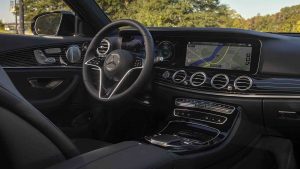
Mercedes calls this system EQ boost.
What’s New
The new 3.0 liter in-line six (and 48 volt starter/generator system) replace the previous 3.0 liter V6 as the E’s optional drivetrain.
Al trims get an upgraded Mercedes-Benz User Experience (MBUX) infotainment system, revised exterior styling and a new-design steering wheel.
What’s Good
Horsepower is maintained, gas mileage goes up.
The price goes up only slightly.
Irrespective of what’s under the hood, the E sedan has a beautifully finished, open-feeling cabin surpassed only by an S-Class cabin – and that not by much.
What’s Not So Good
The new six should never be cycled off.
Gas mileage gains are slight.
Mouse pad controller is hard to use accurately while driving.
The E comes standard with a 2.0 liter four – which would have been considered an unusual engine to find under the hood of a $50,000 luxury sedan a decade ago.
Back in 2011, the Mercedes E came standard with a 3.5 liter V6, which didn’t need a turbo to make its 268 horsepower. The ’21 E’s 2.0 liter four needs one to make its 255 horsepower.
More accurately, it needs to burn (and emit) less gas – in order for Mercedes to continue selling cars like the E without entirely electric drivetrains. The turbo four is a compromise between the all-electric and thus zero gas burning (and emitting) and the too much gas burning (and emitting) V6, RIP.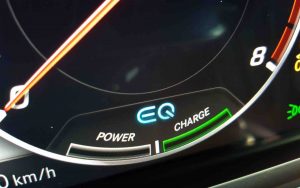
The gas mileage difference isn’t much, however.
The current E’s turbo four rates 22 city, 31 highway while the 2011 E’s 3.5 liter V6 rated 17 city, 25 highway – a picayune difference for a car in the E’s class. But Mercedes has to worry about gas emissions as much as gas mileage – as well as displacement fines for exceeding 2.0 liters of engine back in Europe.
This is why there is a small four as standard now rather than the previous V6.
The good news, in terms of tangible benefit to the buyer of a new E, is that the turbocharged four produces more torque – and sooner. It makes 277 ft. lbs. at 1,800 RPM vs. the RIP’d V6’s 258 ft.-lbs. at 2,400. This makes it feel stronger in the low and mid-ranges than the rest-in-peace V6.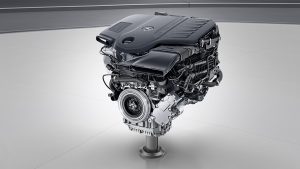
So equipped, an E sedan gets to 60 in about 6 seconds, which is about the same as the old V6 E.
The big news is the return of the straight six.
Mercedes was once famous for such powerplants, which propelled iconic models like the 300SL back in the 1950s and ’60s.
Straight sixes have the virtue of being almost as smooth as an electric motor while making sounds no electric motor can make. This is because the in-line six layout is inherently balanced. No side-to-side vibrations. For that reason, it also doesn’t need a heavy external balancer to tamp down the vibrations. Which means the reciprocating assembly – crank, rods and pistons – are lighter and so rev freer.
It is the perfect powerplant for a sophisticated luxury sedan.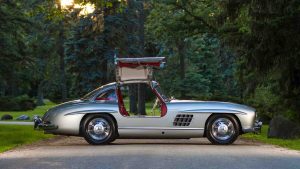
But a six – whether straight or in a “v” – uses and produces more gas than a four, which makes it hard to offer the additional cylinders, whether in line or arranged in a “v.”
Mercedes’ solution is to turn all of them off as often as feasible. And back on as necessary, without the obvious stop/start cycling that would render the inherent smoothness of the inline six as irrelevant as the great taste of food you can’t eat.
The EQ system can be described as a hybrid system and the intent is the same but the means toward that end are different.
Most hybrids have an electric motor – which to one degree or another can propel the car. The Benz has an integrated starter/generator sandwiched in-between the engine and the nine-speed automatic transmission
When the engine is running, it is spinning the flywheel-mounted generator, creating a great deal more electricity (48 volts) than a much smaller alternator being spun by an accessory drive belt.
When the engine’s power isn’t needed – as during coasting/deceleration – the system turns the engine off.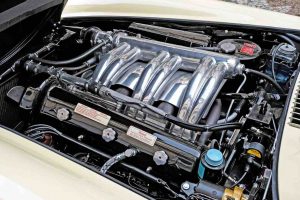
When the engine’s power is needed again – for acceleration – it is spun back to life by the flywheel starter, which is much more powerful by dint of leverage as well as electricity than a standard starter motor bolted to the flywheel and that is what allows for the virtually instantaneous – and seamless – re-starts.
There’s also a slight power boost relative to last year. The output of the EQ-boosted straight six is exactly the same 362 horsepower and 369 ft.-lbs. of torque as that produced by the old V6 – by itself. But the new drivetrain’s peak torque is made slightly sooner, at 1,600vs. 1,800 RPM.
It’s slightly quicker, too, than last year’s V6-only E-Class – getting to 60 in about 4.5 vs. 4.6 seconds.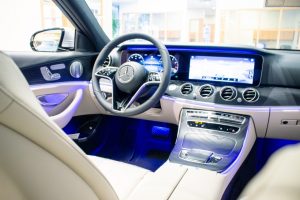
There’s another slight difference as well.
The EQ-boosted Benz rates 23 city, 30 highway – a slight improvement over the previous V6 E’s 20 city, 28 highway.
But it’s difference you can’t see that makes the six possible.
By cycling it off as often as possible, it is possible to keep the quantity of gas the six produces low enough to not cause problems with the geheimstatspolizei – i.e., the government.
It is why other car companies are resorting to the same technological work-arounds (as for example Jaguar, which uses a similar system in the new F-Pace).
BMW, too.
There aren’t – yet – “greenhouse gas” emissions regulations in the U.S. But they are coming and Mercedes and the rest are being proactive.
And the upside is they’re able to sell engines like this new six.
Mercedes touts the seamless transitions and the quiet of the EQ-boosted drivetrain, but it’s the sound of the six that sells this thing. The shame is that so much work was put toward making it silent.
And hiding it.
Underneath that ugly plastic engine cover – an affront right up there with putting swim trunks on Michelangelo’s statue of David – lies one of the most beautiful engines ever put into a car. Instead of showing it off, Mercedes chose to make it look like every other engine by burying it under a shroud that looks the same as the ones covering up ordinary engines.
But is a special engine. It deserves better. One does not put ketchup on wagyu.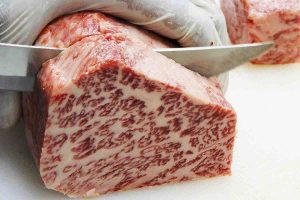
Inline sixes are uncommon, first of all, because their length limits where they can be put. Generally, small cars are out – there’s just not enough room. And front-drive cars are out, too – for the same reason.
But the thing which defines them is their song. Which you’ll hear when you give the E enough pedal to overcome the silent-drive EQ system and the acoustic muffling, including that god-awful plastic cover.
Select Sport+ mode using the little toggle to the left of the mouse trackpad on the center console. The flatscreen gauges go red backlit but it’s not the visuals that excite or even the speed which ensues.
Nothing else makes it. And that – absent any noticeable vibrations – is what makes a straight six something special, to be savored – like a wagyu steak vs. an ordinary ribeye. Both are good.
But one is a rare treat, for the person lucky enough to be able to afford it.
There is something else that makes the E450 special – to be savored.
It is soft.
The seats, the surfaces – the ride. This is not a car for the corners. It is a car for the hours – whether in traffic or headed cross-country.
The feel, including the available massaging seats. Which will make you feel special, which is ultimately the point of spending $60k-plus on any car.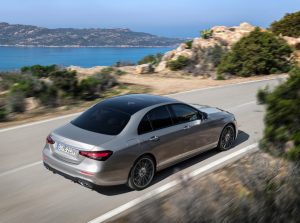
Mercedes put a lot of work toward creating this ensemble, which includes the visual – of the world outside the car, which you can see and which you feel a part of because of all the glass. Many new cars make you feel as though you are driving a bathtub; the doors are high – the glass almost like slits. This is done in part as a cheap-out way to score well in side-impact crash testing.
But how “safe” is a car you can’t see out of?
Driving the E is relaxing as well as inspiring. It has the legs of a Kenyan marathon runner, the lungs of Pavarotti – and the softness of your favorite sofa on a warm summer’s day.
Because there aren’t many like it – under the hood or otherwise.
At The Curb
The E-Class, which is Mercedes’ mid-priced, mid-sized luxury sedan, now comes with or offers essentially the same amenities that used to be exclusive to the S-Class, Mercedes’ top-of-the-line (and full-sized) sedan.
These include an entirely flatscreen panel, not just for the main gauges but also the secondary – Infotainment – displays. The functional advantage to this layout is that more can be displayed because you can toggle various displays.
Physical gauges limit what can be displayed. It also looks razzle-dazzle, though there is a pratfall there – because flat-screen displays are not inherently expensive to put into a car and that is why they are now commonplace in common cars.
Which takes away some from the razzle-dazzle.
But common cars do not – and cannot – offer the creamy-soft leather and other such that cannot be made inexpensive and which abound inside the E.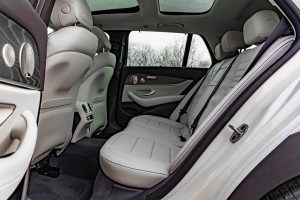
You will also notice other points of departure, such as the beautiful paint under the hood. In common cars – and some luxury cars – the paint in such areas is dull, because it wasn’t clearcoated. In order to save a few bucks per car.
But it makes the car look cheap – and makes you feel gypped if you paid $60k-plus for it.
The one thing you don’t get for your $60k-plus is the rearseat legroom and trunk size of the S-Class. Instead of the S-Class’s limousine-like 43 inches of legroom for the back seat occupants, there’s 36.2 inches – and the E’s trunk is smaller.
But then, so is its price – by about $50,000.
The Rest
You don’t have to buy the six to get everything else Mercedes offers in this class – including the massaging (and bolstering seats) or the heated arm-rests and center pad, the superb Burmester audio system, the adaptive suspension, panorama sunroof, surround view camera or the plethora of luxury/convenience and driver-assistance tech that’s there for the opting. 
A nice feature that end-runs the mouse trackpad input on the center console is the voice-command system. You can change radio station, make a call and get the car to obey a plethora of commands without having to touch anything. This greatly reduces both annoyance and distraction.
Mercedes also thoughtfully includes redundant mechanical inputs for important functions, such as the volume for the sound system, which can be rolled up or down using a very happily tactile thumbwheel on the center console.
There are similarly tactile switches on the center stack to up-and-down the heat/cooling, fan speed and so on.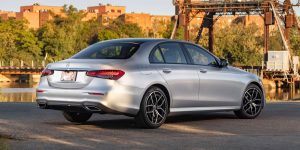
Finally, Mercedes deserves praise for only slightly increasing the price of the new E450 relative to the previous (2020) V6-powered E-sedan, which stickered for $61,550 vs. $62,000 for the new straight-six and EQ-boosted E450.
The Bottom Line
Mercedes has figured out a way to let you have the cake the government didn’t want you to eat – without charging you an outrageous sum to get it, either.
. . .
Got a question about cars, Libertarian politics – or anything else? Click on the “ask Eric” link and send ’em in!
If you like what you’ve found here please consider supporting EPautos.
We depend on you to keep the wheels turning!
Our donate button is here.
If you prefer not to use PayPal, our mailing address is:
EPautos
721 Hummingbird Lane SE
Copper Hill, VA 24079
PS: Get an EPautos magnet or sticker or coaster in return for a $20 or more one-time donation or a $10 or more monthly recurring donation. (Please be sure to tell us you want a magnet or sticker or coaster – and also, provide an address, so we know where to mail the thing!)
My eBook about car buying (new and used) is also available for your favorite price – free! Click here. If that fails, email me at [email protected] and I will send you a copy directly!





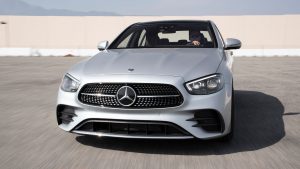
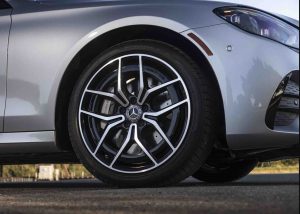









If you drive up a mountain, straining the engine and then coast down the other side, what happens to the excess heat generated during the climb when the motor goes off?
Eric,
We owned a C class coupe for a while, bought it used as a 100K certified car. At 95K the rear end began to whine. The dealer replaced the knuckle under warranty. The repair bill was over $3,500!
We traded it on a new Toyota.
MBs’ while stylish and fun, are way too expensive to own.
Hi Clay,
Luxury-brand cars are expensive to buy – and (usually) to keep. It’s not just because they’re priced higher – although that is a factor (obviously). The other factor is they tend to have more complex/elaborate systems – and these cost more to repair and are generally more likely to need repair, too. It’s the difference between a pair of fine Italian shoes – and a pair of Chucks!
Fine review; however
“the track pad” is just another distraction (why is cell phone use prohibited in Florida while track pads and flat panel displays are ok)
“putting swim trunks on Michelangelo’s statue of David”
It’s coming, the woke crowd will continue to be offended by any display of white-male supremacy.
Eric – have you noticed something – on the second hand market the cars with the nicer engines hold value MUCH more than the base engine cars ? Ive been looking for something nice but always try to go for one with the nicer engines (the V6 at least). But they are all quite a bit more expensive than the normal 2.0 (or less) engines. And forget the V8s – a new E class with the base engine will cost you less than a 5 year old V8 here in the UK!!
I suspect these new luxury cars are being stripped down to be sold as bas spec cars on cheap monthly payments who possibly just want the car for the badge… those who want the actual driving experience may just hold off and look to buy used. And there may be too many of us !
Good point Nasir. I think you’re right.
My brother just bought a used ATS-V, and it was very pricey. I think he paid around 70% of new MSRP for a low mileage late model unit, which seems high, but your theory plays this out.
A while ago I bought a certified normal ATS 2.0T (but it had a stick, yahoo) for less than half his.
Re: plastic engine covers
At one time I was opposed, but not now. My three vehicles all have the covers, which protect the electronics/electrics (coil packs, etc.), on top of the engine, from moisture. I occasionally clean the covers – preferable to cleaning the engine.
If the covers aren’t desired they can be removed.
Or: As long as it’s got the go, I can do without the (engine) show 🙂
Hi liberty,
I miss being able to see the engine – and also that these covers make all engines appear the same – part of the homogenizing trend that leads us to the Johnny Car Transportation Module. It was very refreshing to see the Ram TRX’s engine, which was also painted a glorious Hemi Orange!
not a Merc guy, but that car does look nice inside. Outside, I’m not stunned.
Always liked a straight 6, though I’d like another liter in there
Dan,
What’s your opinion on the old L225?
You being a fan of at least some inline 6’s?
I’ve often fantasized about and old Chevy 80’s Silverado with a Chrysler 225, TBI, and a modern gazillion speed? transmission.
Good on gas, haul all kinds of crap (in moderation), and easy to ingress/egress in my tender years.
I had an R10 with a 305 from 87-2011. Every time I worked on it, I thought the L225 would’ve made it the perfect daily driver.
Tuanorea,
Ok, when I read 225, I thought of the old Riviera. Had to look up a picture to make sure that was what I was thinking, then it reminded me how how ugly I think the 1950’s (and some 60’s & definitely 70s) cars were.
Now I’ll disclaim that I’m not a chevy guy, but in my poorer years I ended up with two chevy’s cause the were cheap, but those square body trucks have a lot of interest these days.
Like probably all in line 6’s, I like the simple(r) design and low end torque. For some reason I find that appealing, maybe since at heart I was always a truck guy.
Far as I know it was a greatly reliable engine, which I also expect out of in lines. I don’t think it was powerful enough, though in the 60’s it was pretty good (I think around 150 HP). Guess I’m just spoiled now. I think you missed putting a turbo on it.
That is a stunning interior. MB has truly come a long way in that regard. Their past interiors were about as inviting as a public transit bus.
It appears they’ve found a way to shrink the steering wheel airbag housing – most attractive steering wheel I’ve seen in a modern vehicle.
Great review Eric, as always. I learned a lot about the new E. I have always been a fan of the E. As a young man, I was enthralled by the 90’s E performance versions (E430?), and they still look great to me. My wife had a ’12 or ’14, don’t remember, with the 3.5 and we really enjoyed it (except for the low profile tires). When they went all 4cyl only, we baled. Looks like maybe others did too, cause the 6 is back, nice. Don’t think I’m too crazy about all the new tech with it, but at least MB is trying to find a way.
Thanks, Chris!
The six in this thing is magnificent; I wish MB would do more to make people aware of it…
I don’t think they want to as people seem to think that they will be battery powered before long.
Why would anyone buy a luxury car anymore?
If a Merc comes with basically the same drive unit as a Hyundai, and offers nothing more in the way of required comforts, why spend 2-3X as much?
Oh, right, we live in “look at me and my stuff” world now.
All I see when I see a luxury car now is someone probably insecure, financial dumb and compensating for a shortcoming.
“…Displacement fines for exceeding 2.0 liters…”
WTF?
Also, the four cylinder looks like an ungodly cluster. Good thing people with this kind of money don’t work on cars themselves.